This post was written by Shari Siegel ’18
Four members of The Sustainable Innovation MBA Class of 2018 — Ian Dechow, Andria Denome, Kaitlin Sampson and Shari Siegel — recently headed south to attend the inaugural Climate Cap Summit at Duke University. The Summit was a chance for our travelers to listen to and exchange views with professional investors, bankers, scientists, financial strategists and advisors, corporate executives, academics and MBA students from other schools on a variety of business, finance, political, and social issues related to climate change and other sustainability challenges.
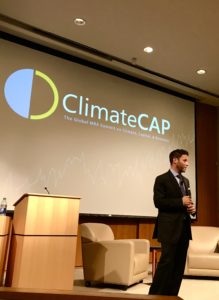
The program opened with a keynote presentation by Scott Jacobs, co-founder of Generate Capital, and a conversation between Jacobs and Greg Dalton from Climate One. Jacobs posited that the challenge of “clean tech” is not so much about invention as it is about infrastructure: energy, land, water, food and clean air are critical and are made available through infrastructure, which requires substantial capital up-front. Thus, while there are hundreds of infrastructure projects that it might be in economic actors’ rational self-interest to pursue, it is often difficult to get these projects funded.
For the owners/developers of the technology, the “Silicon Valley” funding model (a small investment in a small, early stage company with the potential for rapid growth at exponential returns) does not fit: these companies have proven (potentially improved) technology that requires substantial investment that will yield long-term steady, but not exponential returns. For the potential clean tech customers, investing in a large capital project with substantial up-front costs that turn what was an operating expense into a capital expenditure is a difficult decision to make, especially in the current capital markets environment where there is so much focus on short-term results rather than long-term sustainability.
The solution proposed by Jacobs and his co-founder at Generate, Jigar Shah, is to provide “infrastructure as a service” using project finance structures under which independent developers build and operate infrastructure owned by a special purpose company financed by Generate. It is, in many ways, a macro version of successful strategies studied by students in The Sustainable Innovation MBA in connection with bringing solar power, mobile phone service, and other technology to the base of the pyramid.
The opening discussion was followed by a discussion between Truman Semans, founder and chief executive officer of Element Strategies and Matt Arnold, global head of Sustainable Finance at JPMorgan Chase regarding environmental, social and governance (“ESG”) investing, the UN Sustainable Development Goals (“SDGs”) and risk management.
Attracting private investment in projects related to the SDGs requires reducing risk for the providers of capital. Among the strategies to further risk reduction is better (more transparent and standardized) disclosure relating to ESG matters. The speakers noted the ESG disclosure scores promulgated by Bloomberg. Another risk-reduction strategy is the one put forward in the Blended Finance, Better World discussion paper released for discussion by the World Economic Forum in 2017.[1] It proposes using multilateral development banks to provide public money which can attract investment of private capital into major infrastructure projects in the developing world to meet the SDGs. Estimates are that investment of approximately US$6 trillion is needed annually to meet the SDGs.
Later panels returned to the subject of assessing ESG factors as part of fundamental long-term risk management. While in the early days of ESG investing, such a strategy was thought to reflect a willingness to eschew higher returns in exchange for desired impacts, it is becoming increasingly clear that investors ignore environmental, social and governance aspects of a company’s operations at their peril and incorporating ESG factors into an investment strategy likely leads to better long-term performance. As Ron Temple, head of US Equities and co-head of Multi-Asset Investing at Lazard Asset Management, said, it is “simply irresponsible” not to look at ESG factors in evaluating risk.
Elizabeth Lewis of Terra Alpha Investments, Mark McDivitt of State Street Corporation and Kate Gordon of the Paulson Institute agreed, particularly when talking about climate change. According to the 2017 Global Risks Report published by the World Economic Forum, extreme weather events and natural disasters are two of the top 5 global risks in terms of likelihood to occur and impact; water crises and failure of climate-change mitigation and adaptation are also in the top 5 global risks in terms of impact.[2] The key to talking about business and climate change is to understand the pricing of climate change risk.
Fundamental risk and opportunity presented by ESG factors, especially those relating to climate destabilization, was hammered home again in a later presentation by Tiiram Sunderland of Bain & Co, who noted that climate change represents the biggest issue affecting business today. He also noted that unless sustainability is embedded in the core of a business school’s curriculum, the school is failing its students.
This last point was, of course, happily endorsed by The Sustainable Innovation MBA students.
[1] See https://www.weforum.org/reports/blended-finance-toolkit.
[2] See http://reports.weforum.org/global-risks-2017/.
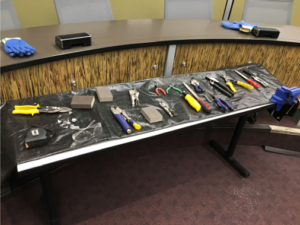 Against the auditorium style seating a table was set up and laid out with what could be confused as the tools from Dexter’s laboratory, a motley assortment of pliers, saws, metal files, and safety goggles were spread over a black tarp. On a second look around the room you notice a type of pinball style launching devices affixed to the front desk, a ping pong ball loaded into its cartridge, aimed at narrow vertical strip of peg board. On the ground in front of the desk beyond the pegboard barrier were two lines of tape outlining what we would come to learn was a landing strip of sorts. We were not sure what to think of this odd display as we took our seats, but were quickly informed by the excited and jovial explanation from Mike Rosen, our guest lecturer for the day.
Against the auditorium style seating a table was set up and laid out with what could be confused as the tools from Dexter’s laboratory, a motley assortment of pliers, saws, metal files, and safety goggles were spread over a black tarp. On a second look around the room you notice a type of pinball style launching devices affixed to the front desk, a ping pong ball loaded into its cartridge, aimed at narrow vertical strip of peg board. On the ground in front of the desk beyond the pegboard barrier were two lines of tape outlining what we would come to learn was a landing strip of sorts. We were not sure what to think of this odd display as we took our seats, but were quickly informed by the excited and jovial explanation from Mike Rosen, our guest lecturer for the day.
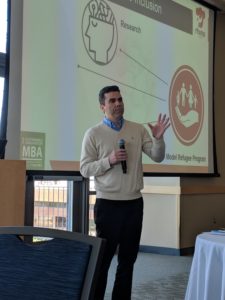
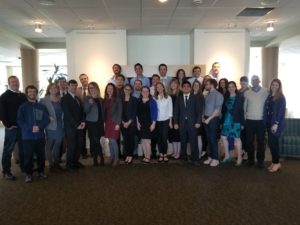 Students pitched scoping for projects at companies such as Keurig Green Mountain, Griffith Foods, Essilor, Seventh Generation, and Caterpillar.
Students pitched scoping for projects at companies such as Keurig Green Mountain, Griffith Foods, Essilor, Seventh Generation, and Caterpillar. Mike Dupee, Lecturer in The Sustainable Innovation MBA program and a Certified Biomimicry Professional, introduced us to biomimicry, which is the innovation approach centered on the “conscious emulation of nature’s genius.” As humans strive towards innovation – doing things faster, better, more creatively, and at lower cost – looking more closely at the natural world around us shows that this is one of the oldest processes on the planet. The plants, animals, and microbes that have survived the 3.8 billion years of our planet are the ultimate innovators and as businesses seek to solve problems and develop new strategies, there is much that can be learned from them.
Mike Dupee, Lecturer in The Sustainable Innovation MBA program and a Certified Biomimicry Professional, introduced us to biomimicry, which is the innovation approach centered on the “conscious emulation of nature’s genius.” As humans strive towards innovation – doing things faster, better, more creatively, and at lower cost – looking more closely at the natural world around us shows that this is one of the oldest processes on the planet. The plants, animals, and microbes that have survived the 3.8 billion years of our planet are the ultimate innovators and as businesses seek to solve problems and develop new strategies, there is much that can be learned from them.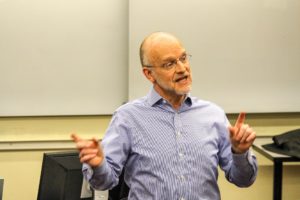 Reed got his start in advocacy and grassroots work in Michigan. He discussed the evolution of his thinking from an “us versus them” mentality (environmentalists versus business) to understanding business’s role in society (and the part that sustainability-minded professionals can play).
Reed got his start in advocacy and grassroots work in Michigan. He discussed the evolution of his thinking from an “us versus them” mentality (environmentalists versus business) to understanding business’s role in society (and the part that sustainability-minded professionals can play).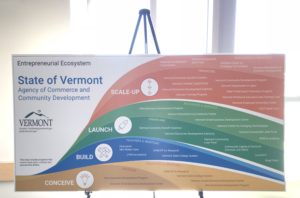 On April 5th, 2018 the University of Vermont hosted the 13th annual Invention2Venture Conference for entrepreneurs, inventors and students alike. The conference focused on how to finance, protect and commercialize inventions, as well as how to thrive in the New England tech world.
On April 5th, 2018 the University of Vermont hosted the 13th annual Invention2Venture Conference for entrepreneurs, inventors and students alike. The conference focused on how to finance, protect and commercialize inventions, as well as how to thrive in the New England tech world.

 Sixty-three pounds of plastic, per person, ends up in landfills in the United States. An increased consumer demand for sustainability and the amount of waste coming from disposing packaging makes companies re-think their packaging. They start to incorporate new, sustainable materials and construction methods into their packaging to reduce their impact on the planet. Here’s four clever ideas for companies to reduce their carbon footprint by changing their packaging:
Sixty-three pounds of plastic, per person, ends up in landfills in the United States. An increased consumer demand for sustainability and the amount of waste coming from disposing packaging makes companies re-think their packaging. They start to incorporate new, sustainable materials and construction methods into their packaging to reduce their impact on the planet. Here’s four clever ideas for companies to reduce their carbon footprint by changing their packaging: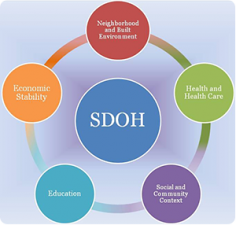 The
The  This
This